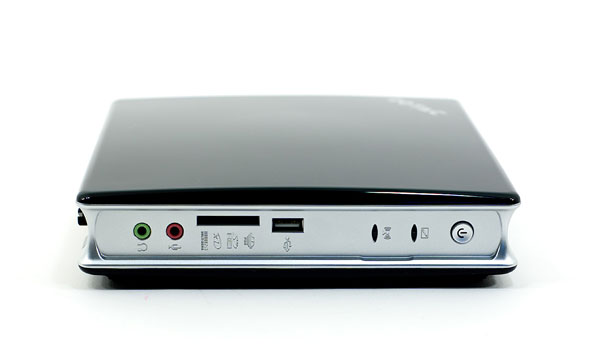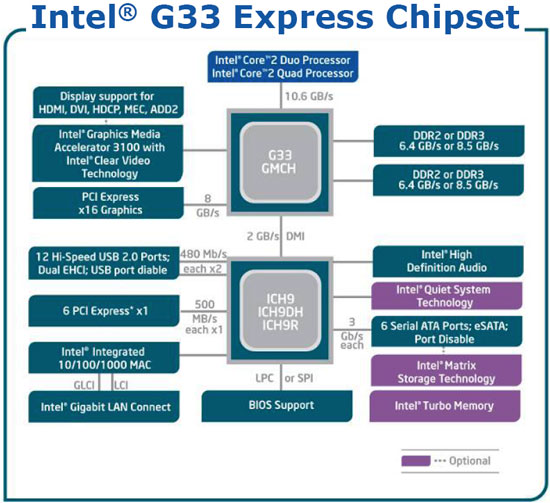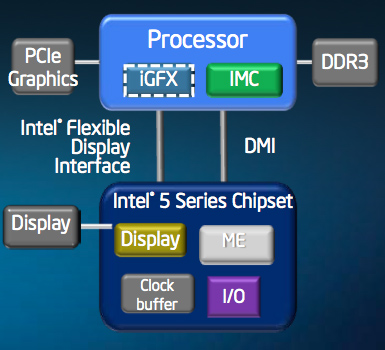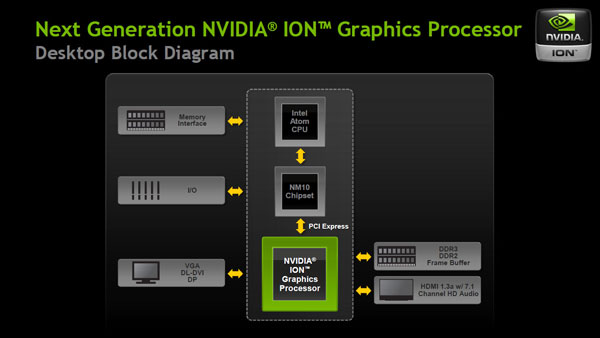Zotac ZBOX HD-ID11 Review: Next Gen ION is Better & Worse than ION1
by Anand Lal Shimpi on May 6, 2010 3:51 PM EST- Posted in
- GPUs
- Next Generation ION
- HD-ID11
- ZOTAC
- NVIDIA
The nForce 2 was one of the best chipsets to come out of NVIDIA. It was NVIDIA’s second attempt at a desktop chipset yet it cemented NVIDIA’s position as a leading provider of core logic in the market. Oh how much has changed since then.
Most of what made a chipset worthwhile is now integrated into the CPU. It used to be memory controller optimizations that kept chipsets afloat, but that’s no longer the case as all x86 processors now ship with an integrated memory controller. The performance differences between chipsets disappeared and all that was left was testing, validation and drivers, also known as the boring, expensive and time consuming aspects of chipset development.
NVIDIA has mostly abandoned the chipset business, focusing on opportunistic wins where possible. The most obvious example is with ION, its chipset/GPU for Atom based systems.

Last year we played with a number of ION systems and motherboards and were generally impressed. The platform made for a powerful little HTPC. Today we’re able to bring you a hands on performance preview of the first Next Generation ION box we’ve laid our hands on: the Zotac ZBOX HD-ID11.
Terms of Ndearment
CPUs connect to the outside world using proprietary bus interfaces. AMD uses Hyper Transport, while Intel previously used the AGTL+ FSB. In order to build a device that hangs off of this interface you need a license to use it. This is just an IP license to let you integrate the circuitry you need to communicate over that bus onto your silicon. It’s pretty commonplace.
Over the years Intel would update its FSB (Front Side Bus) specification, and it would threaten its chipset partners with revoking their license to the new version of the FSB unless they cooperated. Intel and VIA had a disagreement over this years ago that ended in VIA threatening Intel with CPU patents and the two coming to terms later on.

The old way of doing things, FSB between the CPU and the GMCH, DMI between the GMCH and ICH.
With Nehalem, Intel moved away from a parallel bus interface and introduced QPI (Quick Path Interconnect). This is a very high bandwidth point to point protocol designed for high end servers, workstations and desktops. It’s used in the Nehalem and Gulftown based Core i7s. NVIDIA said it had no interest in pursuing a QPI based chipset, so the issue of licensing never came up.

The new way, QPI between the CPU and IOH. DMI between the IOH and ICH.
A much lower bandwidth interconnect called DMI (Direct Media Interface) would be used for mainstream Nehalem/Westmere derivatives (e.g. Core i3, Core i5, LGA-1156 Core i7). Intel had used this interconnect in the past to connect parts of its chipsets together, but now it would be used to connect the CPU to a chipset.

The other new way: DMI between the CPU and chipset.
With its own aspirations of getting into the GPU market, and no real need for NVIDIA’s allegiance, Intel enforced its license agreement and threatened a lawsuit if NVIDIA sold chipsets that used Intel’s DMI. NVIDIA argued that it was well within its rights to do so but didn’t want to risk it and stopped development on DMI chipsets pending the outcome of its lawsuit against Intel for violating the terms of the license agreement.
The ION Problem
While all of this was going on, Intel’s Atom platform started gaining momentum in netbooks and nettops. The netbook version of Atom used the old AGTL+ FSB to connect to its chipset, so NVIDIA could technically produce chipsets for it. Which is exactly what NVIDIA did. It was called ION (and later renamed to Atom + ION).
The latest version of Atom for netbooks/nettops, codenamed Pineview, integrates the memory controller and graphics core. Its only connection to the outside world is, you guessed it, a DMI link.

In a Pine Trail Atom system, the Pineview CPU connects to Intel’s NM10 Express chipset over this DMI link. With no license for DMI and no desire to push its luck, NVIDIA can’t offer a drop in replacement for the NM10 Express chipset.
Luckily, Intel’s NM10 Express Chipset includes four PCIe 1.0 lanes. A motherboard manufacturer could simply hang a low end, discrete GPU off of these PCIe lanes and you’d get a modern ION platform. And that’s what NVIDIA did for its Next Generation ION.
Meet NG-ION
NVIDIA’s Next Generation ION is a 40nm discrete GPU based on the GT218 core, it’s effectively the same GPU as a desktop GeForce 210 video card with some differing clock speeds. The nettop version uses 16 cores, while the netbook version uses 8 or 16 depending on the screen size.
While manufacturers can use all four PCIe 1.0 lanes coming off Intel’s NM10 Express chipset, most have chosen to use just one leaving the remaining lanes for things like WiFi. A single PCIe 1.0 lane can only provide 250MB/s of bandwidth in either direction, hardly enough for a modern GPU. It’s because of this limitation that the next-generation ION GPU could actually perform slower than the first ION.

As a discrete GPU, the NG-ION comes with its own frame buffer: up to 512MB of DDR3 on a nettop. You also get full H.264 video decode acceleration and support for 8-channel LPCM audio over HDMI out.















40 Comments
View All Comments
Rayb - Thursday, May 6, 2010 - link
I'll go with the ION1, since the flash 10.1 patch everything else became a non issue.QChronoD - Thursday, May 6, 2010 - link
Are there any tiny systems like this out there which have something faster than an Atom that use the ION chipset?sprockkets - Thursday, May 6, 2010 - link
Yes, but only if you want an LGA775 processor. It uses the 9300/9400 chipset, which is basically the same thing.Works great. Except I really, really want fanless.
icrf - Friday, May 7, 2010 - link
I've got a Wolfdale HTPC now with one of the Zotac NV9300 Micro-ATX boards, and it works, but it's noisy. The lack of wake-on-USB from S3 and the lack of fan control access from Windows pissed me off about the board enough I'll probably avoid Zotac boards for the foreseeable future. I can live without the wake on USB from S3, but not being able to dynamically control fan speeds is just terrible. Every motherboard I've bought for more than the last five years have had that. I didn't even think to look for it.More than a little OT, but for me, the big competition for this is something like the Boxee Box, which I haven't heard a peep about since CES. Anyone know any more details about it? I thought it was originally slated for 1H10 but I've seen a bare 2010 quoted, too. I'd probably pick one of those up just to see how well it'd work. I'd be on the pre-order list if I knew I could get XBMC running on it. I've got Boxee, XBMC, and Hulu installed on my HTPC now and can flip between them. Boxee is the one run least often because the other two do what they do much better.
hpmoon - Friday, May 7, 2010 - link
My suspicion about the Boxee Box delay is quite simply that the media assholes are standing at the ready (and have scared Boxee to this effect) for suing them with full force as soon as the hardware hits the market. They must believe (or at least their questionably schooled lawyers must believe) that the legal ramifications suddenly change when it's not just a PC running the Boxee software and thus framing Firefox Web site visits anymore, but an actual non-PC device doing something very different without full-blown Firefox PC functionality.Of course, if this were the backstory, no one would tell you this.
icrf - Friday, May 7, 2010 - link
The experience of running Hulu through Boxee is bad enough I'm not sure I'd worry about it too much. You can play/pause it, but that's it. Seeking forward or backwards isn't supported. If the stream dies halfway through and you need to restart, or you have to pause it for a long time and the connection times out, or if you just want to repeat what someone said, you're SOL.If I'm wrong and some of this got fixed, someone holler, but Boxee seemed more about the social aspect than anything else. You can get these little clip videos from all over the internet, publicize what you're watching and what you like or don't, etc.
ClagMaster - Thursday, May 6, 2010 - link
I wonder if the memory controllers on board the AMD and Intel CPUs are as optimized as those found on the P965, P35 and P45 ?The P965/G965 has a wonderful memory controller that was far more efficient than that on the AMD 64.
How can one evaluate this ?
aj28 - Thursday, May 6, 2010 - link
A bit off topic, but I think it's worth pointing out that AMD64 (754/939) was a DDR controller, while Intel's P965 was a DDR2 controller. I miss the old nForce controllers, which were some of the more feature-rich, error-free (at least in my experience) chipsets out there. It's a shame that Intel has designed their new platform the way they have...Calin - Friday, May 7, 2010 - link
NVidia chipsets had that issue with the disk controller (the possibility to totally trash the content of your hard drive). Other than that, they were for quite a time the high point in chipsets. The only "hotter" chipset I remember was the "BX-100" variant (Intel's 66MHz 440BX chipset, made to run with the Pentium !!! processors on a front side bus of 100MHz).rnjeezy - Thursday, May 6, 2010 - link
yes, i know there's a point in having it, but it's probably good to have another m.b which removes it, and then add one more lane to the gfx